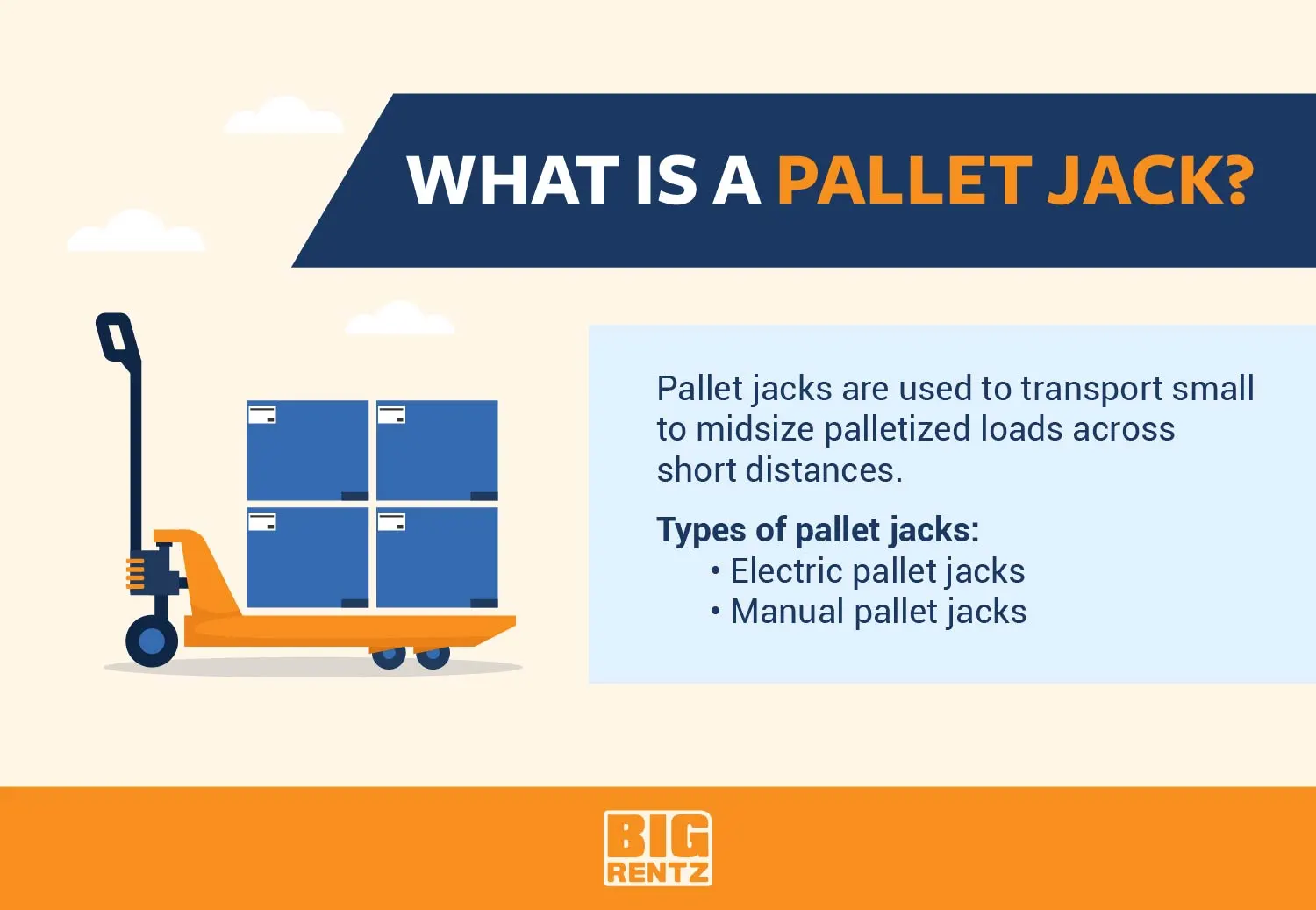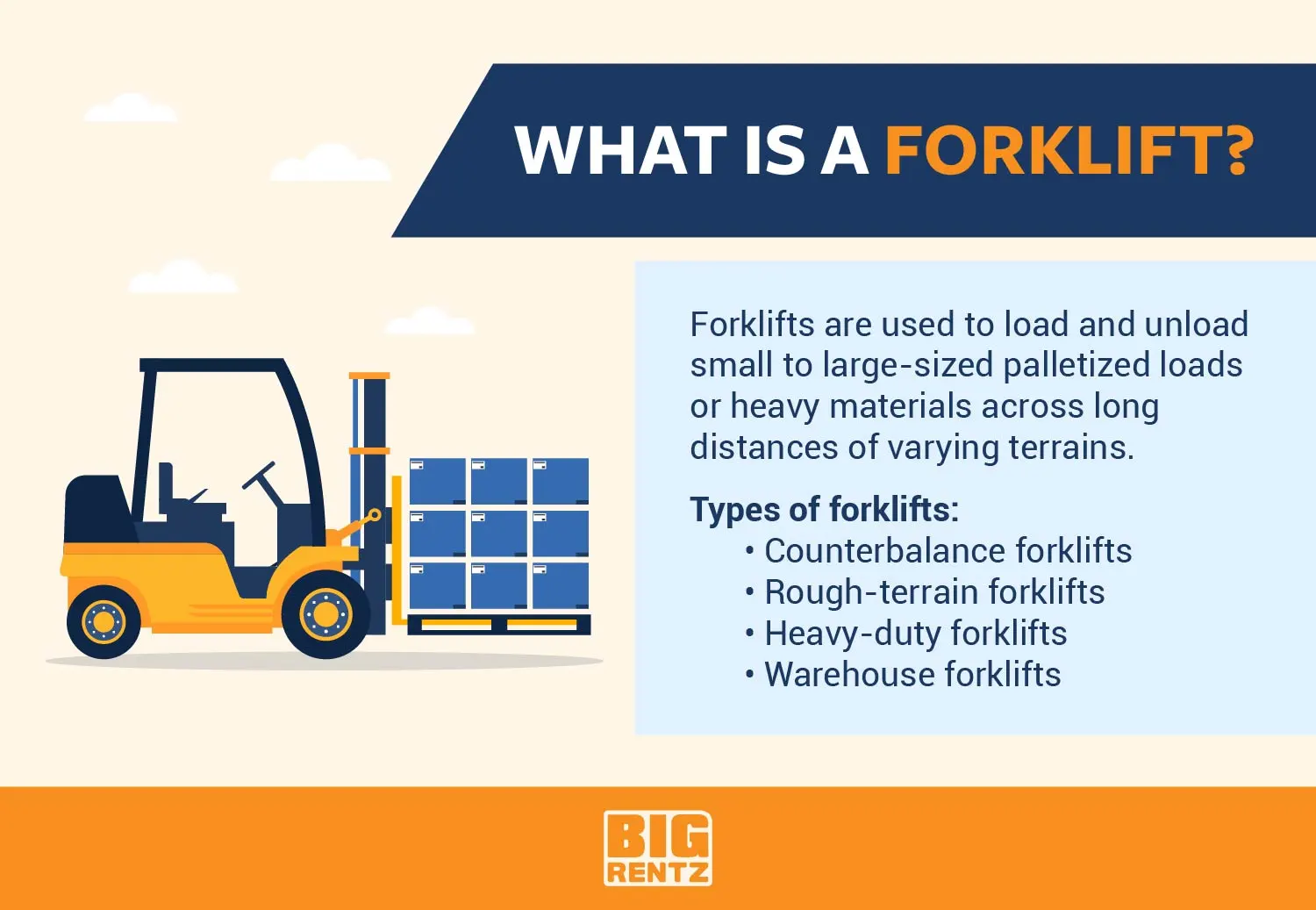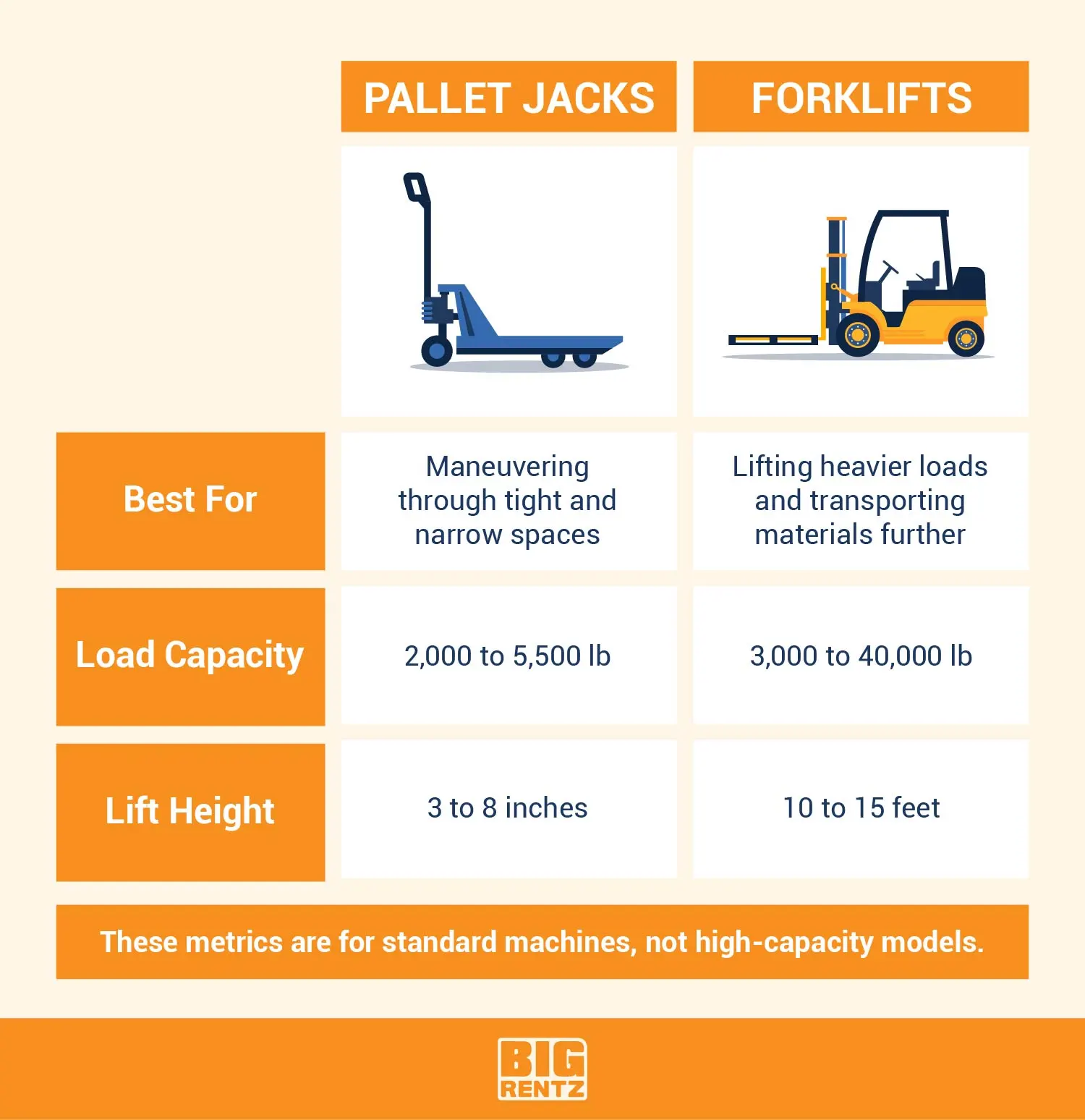OSHA classifies pallet jacks and forklifts under the same umbrella, as powered industrial trucks. You can use both types of equipment for material handling so that you can lift and transport loads. Although you can use them for similar functions, which one you choose depends on your required load capacity, lift height, and cost.
You can easily maneuver pallet jacks through tight spaces, such as narrow aisles in a warehouse, because they are smaller than forklifts. When you need to lift relatively small loads, up to about 5,500 pounds, and carry them over short distances, you can use standard pallet jacks, but if you need to handle considerably heavier loads, you need to use a forklift.
Because you can use a forklift to transport materials over longer distances, navigate rough terrain, and lift loads higher than pallet jacks, you’ll find them to be more useful for construction and industrial settings. Considering that some standard forklifts can handle upwards of 40,000 pounds, you also have better versatility using forklifts for heavy-duty tasks.
In this post, we compare pallet jacks and forklifts and list the pros and cons of each, so you can figure out which machine is the best fit for your project.
Explore All Forklifts
What Is a Pallet Jack?
Often used in settings like warehouses, facility centers, or retail stores, you can use pallet jacks, also known as pallet trucks, to transport loads on pallets, but you typically only use them for short distances.

Pallet jacks come in two main types:
- Manual pallet jacks: Also known as hand pallet trucks, you power manual pallet jacks with your own manual labor. As the name suggests, these pallet jacks require a human operator to work. Because they rely on manual operation, they usually have lower load and lift capacities than electric pallet trucks. In terms of variety, you can find a few different types of manual pallet jacks that might suit your needs, including weighing scale, adjustable, all-terrain, and mini pallet jacks.
- Electric pallet jacks: Also known as powered pallet jacks, you power electric pallet jacks through an electric motor with a rechargeable battery, and you can raise and lower the forks using electronic controls. Typically, electric pallet jacks offer you higher load and lift capacities than manual pallet jacks, and you can choose from several common, useful varieties, including electric and counterbalanced walkie stackers, riders, and off-road pallet jacks.
What Is a Forklift?
Although pallet jacks can lift and transport loads, when you need to lift heavy loads or transport loads over longer distances, forklifts make the best option for your needs. In settings like warehouses, construction sites, lumber yards, and dockyards, you can use forklifts to lift, carry, and transport heavy loads.

You can choose from several types of forklifts designed for specific applications to meet your unique needs. From warehouse forklifts, like reach trucks, side loaders, telehandlers, counterbalance forklifts, and rough-terrain machines, you can even find forklifts powered by combustion engines as well as ones that run on electricity.
Pallet Jacks vs. Forklifts: The Key Differences
While pallet jacks and forklifts offer excellent choices for material-handling equipment, they each have capacities and limitations that make them better suited for specific tasks. If you want to better understand the key differences between these machines, these sections give you the details you need. Weighing these differences can help you select the right machine for your next project.

Forklifts Can Lift Heavier Loads
If you need to lift heavy loads, forklifts make quick easy work of it for you. When you have loads ranging from 5,000 to 40,000 pounds, you can find a standard forklift capable of lifting those loads, and you can use a heavy-duty forklift to lift even more. When you check out different models, you’ll notice that larger forklifts typically have higher lift and load capacities.
However, you can only use standard pallet jacks for lighter loads, when lifting loads between 2,000 and 5,500 pounds. You can find some pallet jack models that offer heavy-duty, high-capacity load capacities, able to lift up to 15,000 pounds.
Pallet Jacks Can Maneuver Through Tight and Narrow Spaces
While forklifts may work best for heavier loads, pallet jacks offer unbeatable maneuverability. With their compact size, you can use pallet jacks to easily navigate tight spaces with your pallet-sized loads. If you need to maneuver loads in narrow areas, such as aisles in stockrooms and warehouses, forklifts don’t offer the same seamless maneuverability as pallet jacks.
Forklifts Have More Mobility
Although you can use a pallet jack to best maneuver through intricate, narrow spaces, when you need to transport loads over longer distances, especially heavier loads, forklifts offer the power you need. You lose mobility with standard pallet jacks, which require you to push or pull the load, and pallet jacks can’t offer the heavy-duty or rough-terrain mobility your project might require.
Forklifts Are More Versatile
Because you generally only use pallet jacks in indoor settings, like warehouses and grocery stores, forklifts offer greater versatility. If you have projects in both indoor and outdoor applications, you’ll find a forklift gives you the versatility to handle loads for warehouses, loading docks, and construction sites.
You can further enhance the versatility of a forklift by using a wide variety of forklift attachments to expand the tasks you can complete. From carpet poles, cylinder caddies, and different types of forks that can be switched out based on your job, you can use a forklift for more than just palletized loads.
Pallet Jacks Have a Lower Lifting Height
If you need to move pallets that are stored on the floor, pallet jacks may be the right choice for you because they don’t lift loads very high off of the ground.
You should select a standard pallet jack if you only need to lift loads about three to eight inches off of the ground. If you need to lift loads higher, you might be able to use specialty models to meet your needs. However, if you want to lift more or reach higher heights, you should use a forklift instead.
Pallet Jacks Cost Less
If cost is a concern, pallet jacks offer the most cost-effective option. For example, if you need it for a month, you can rent a pallet jack anywhere from $204 to $542. On the other hand, when renting a basic forklift, you could spend from $1,200 to $3,475 for a month.
Forklifts Require More Maintenance
You have to perform more required maintenance on forklifts, including
- A full maintenance and service check for every 200 to 250 hours of operation or at a minimum of every six weeks
- A daily inspection, looking for damage and ensuring the forklift functions before use
When you use pallet jacks, however, you tend to use them for smaller loads, indoors, and on concrete, resulting in less wear and tear.
Forklifts Weigh More
Since they require a manual source of power, you’ll find that pallet jacks weigh quite a bit less than forklifts. Pallet jacks may weigh anywhere from 100 to 2,000 pounds, while forklifts clock in with an average weight of 9,000 pounds. Typically, the more a forklift weighs, the higher its load capacity.
So, depending on the model, you can find a forklift that weighs anywhere from 3,000 to 85,000 pounds, which means you can select from a wide variety of load capacities to find the one that works best for your job.
Do You Need a License to Operate a Pallet Jack or Forklift?
You must be trained to operate a pallet jack or forklift. Manual pallet jacks simply require training, while electric pallet jacks and forklifts require certification, per OSHA guidelines. Employers must provide the certification, and you will undergo specific training, both written and hands-on. You must also complete a performance evaluation to ensure you’re ready to operate the machine.
If you want to operate a forklift, you have to be at least 18 years old.
How to Choose Between a Pallet Jack or Forklift
When choosing the right equipment for your project, you need to consider your project’s needs and limitations. Before you make your selection, detail your budget as well as the conditions of the jobsite and terrain. Hauling large loads for long distances may require a forklift, but you may be better off with a pallet jack if you’re just moving pallets through narrow spaces.
Once you decide which type of material-handling equipment you need, you easily rent a pallet jack or forklift through BigRentz. With a wide variety of equipment to suit a range of projects, you can find the perfect piece of machinery for your next job.
Explore All Forklifts